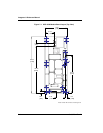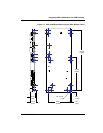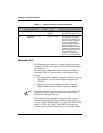
Integrator’s Reference Manual
7-12 80-99208-1 Rev. D
Diagnostic Port
The Diagnostic port consists of a single DE-9 male upright
connector, located on the right side of the GSP-1620 modem
(see Figure 7-1).
By connecting a Diagnostic cable (included in the Modem
Integrator’s Kit) or a custom cable to the Diagnostic port,
you can:
• Service-program a modem or upgrade its software, using
the Globalstar User Terminal Program Support Tool
(UTPST).
• Monitor or verify some modem functions, using the
QUALCOMM Globalstar Modem Operation Monitor.
Note
Normal field usage does not require that a cable be connected to the
Diagnostic port on the modem, since the port is typically used for
development and programming only.
The Diagnostic cable includes a switch box that controls
whether the cable’s DTR (Data Terminal Ready) signal is
asserted (“POS 1 DTR to GND”) or de-asserted (“POS 2 DTR
Open” or “POS 3 Not Used”). When DTR is asserted, the
modem powers up immediately if power is provided. Before
24 SPKR_N Analog Output from
modem
Analog speaker output
(Reserved for Future Use)
25 MODULE_
RESET_N
TTL Input to modem Hard reset of the modem,
inverted logic. This line
should be left floating for
normal modem operation.
In case the application
detects that the modem is
not responding, it can
initiate a hard reset of the
modem by pulling this line
low (below 0.3V) for more
than 5 seconds. The
modem will reboot after
the line is allowed to float.
Table 7-1. Interface Connector Pinouts (continued)
Pin
Number
Signal Name Signal
Level
Direction
User <-> Modem
Description


















